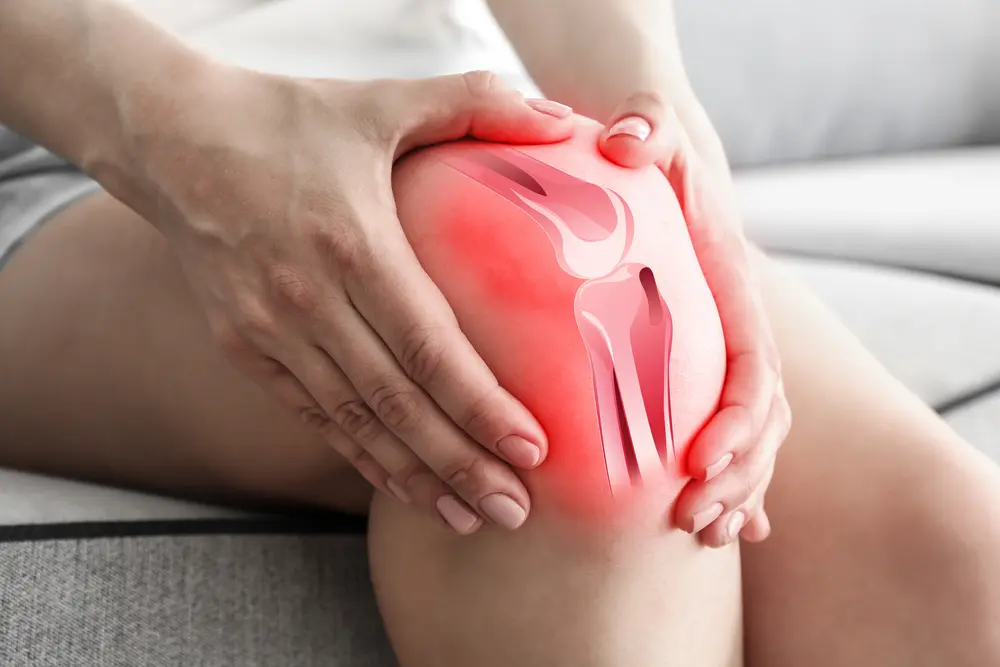
Knee pain, also known as gonalgia, can be very troublesome on a daily basis. Indeed, the knee is an indispensable joint in almost all our movements. In addition, it is a complex joint composed of bones, meniscus, ligaments, muscles and tendons. Each of these elements can cause knee pain!
Gonalgia can be caused by a wide range of factors:
- violent shock
- overuse of the knees
- obesity
- fracture
- rupture of a ligament
- repetitive movements
- lesions
- aging
- improper running technique
There are many types of knee pain. Learn more about the most common types.
Osteoarthritis of the knee
Osteoarthritis is the normal or early deterioration of joints that affects nearly 10% of Canadians over the course of their lives. The knee is the joint most affected by this condition.
Osteoarthritis of the knee usually occurs with age and thus primarily affects people 65 years of age and older. Overweight people or very active athletes can also be affected. This chronic joint disease is caused by a progressive breakdown of knee cartilage (meniscus). This cartilage eventually disappears completely or partially, making the joint more unstable.
This situation can lead to much physical discomfort:
- knee pain, which increases as you move about
- reduced mobility
- swelling of the knee
- deformation of the knee
- feeling of stiffness in the knee
To date, there is no single method to completely cure osteoarthritis of the knee. However, it is possible to relieve knee pain and improve your mobility with the help of certain medications or treatments.
Since knee osteoarthritis is degenerative in nature, it is important to consult quickly if you think you may be suffering from it, in order to establish a treatment plan to limit its progression, reduce pain and maintain your overall health.
The patellofemoral syndrome
Patellofemoral pain syndrome (PFPS) is a pain in the knee, experienced in the area of the patella. This condition often affects active people and teenagers who are experiencing growth spurts. In addition, women are affected more often than men.
This knee pain is caused by a generalized inflammation of the knee joint. This is usually secondary to a poor alignment of the knee or patella. This irregular contact between the patella and the femur leads to discomfort that can take several forms:
- knee pain during sports
- loss of mobility of the patella
- deformation of the knee
- pain when walking up and down stairs
- pain while in a sitting position
- blockage in the knee
One of the best ways to prevent this condition is to perform adequate stretches before physical activity and to do knee strengthening exercises. Patellofemoral syndrome can be caused by an improper running technique associated with flexibility problems in this joint.
If you experience pain in your patella area after sports, you can apply ice. And most importantly, do not hesitate to consult a podiatrist for an evaluation and suggested treatment options.
Pes anserinus bursitis
Pes anserinus bursitis occurs in 3 tendons located in the upper portion of the tibia. The primary purpose of the pes anserinus is to stabilize the knee during physical movements. This is why runners or cyclists are among those most commonly affected by this type of knee pain.
This inflammation of the tendon is often caused by sudden movements. People in very physical professions, where the knee is under great stress, are therefore at greater risk. Women aged 50 and over or people suffering from rheumatism may also be affected.
Poor posture can also be a cause, especially if your foot tends to turn outwards, which creates pressure on the tendons.
Keep on the lookout for symptoms of pes anserinus bursitis:
- progressive pain below the knee, in the tibia area, exacerbated during physical activities
- swelling of the knee
- difficulty moving about
- formation of a nodule (a small scar ball) under the skin
To help prevent this from happening, make sure you stretch well before exercising and stay hydrated. Also avoid repetitive or sudden movements. The podiatrist can help you in preventing or treating this condition.
Genu valgum
The valgum knee (or genu valgum) is a knee pathology whose pain sometimes resembles that of osteoarthritis or patellofemoral syndrome, which are often a result of this condition. This is a deformity of the legs, which curl inward, causing the knees to touch each other. The greater the deformity, the greater the risk of developing secondary pain.
This condition often affects young children. However, it usually corrects itself over time. But in some cases, the deformation becomes more pronounced and then treatment becomes necessary. Sometimes it is necessary to wear an orthosis to limit the progression of the deformity and help the knee to regain proper posture during the growth process.
Although often painless, the valgum knee can eventually become pathological and cause complications if left untreated:
- pain while walking
- wearing of knee cartilage, leading to arthritis of the knee
- unevenly distributed weight in the legs and feet
Thus, knee pain will usually occur in cases where genu valgum is not treated. It is therefore important for parents to ensure that their child’s deformity does not become more significant. A health care professional can be consulted for assistance.
PiedRéseau, find solutions to your knee pain
Gonalgia is far from an uncommon condition. Every year, many Canadians consult their podiatrists to treat various forms of knee pain. The faster you act, the better your chances are of relieving these knee pains.
Rediscover your quality of life by visiting a PiedRéseau clinic near you. We are available to answer all your questions and help you back to health quickly, throughout the province of Quebec.